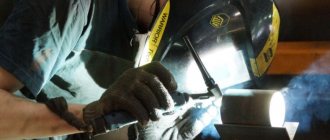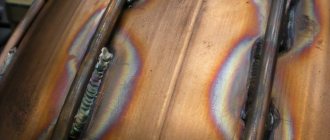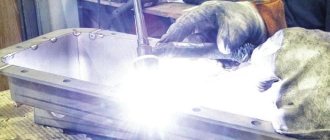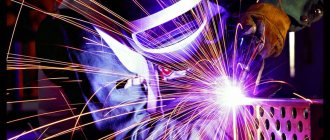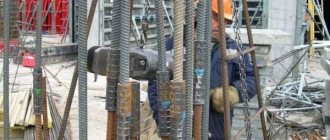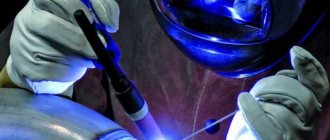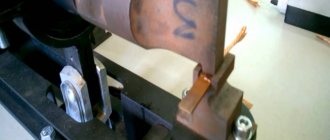A common problem with processing non-ferrous metals (and their alloys) at high temperatures is that under such conditions they are easily deformed.
The specificity of welding brass (copper + zinc) also lies in the fact that, firstly, the element “Zn” included in its composition (30th position in the periodic table) begins to evaporate already when heated to +420 ºС. Secondly, this process is accompanied by the release of a toxic component - the oxide of this metal. The technology of welding brass using argon is the most promising technique, as it eliminates many difficulties and ensures high speed of operations. What it consists of, what are the features of this work is the topic of this article.
Features of brass welding
Brass is a difficult to weld alloy of copper and zinc. Elements such as nickel, tin and lead can be added to the alloy. During welding, zinc is actively released, which causes the appearance of pores and reduces the strength of the joint. The thermal conductivity of the alloy exceeds even steel. Therefore, it is recommended to use a high-power torch for processing brass products.
To eliminate negative processes, it is recommended to adjust the burner so that the excess oxygen is at least 25%. This will reduce the porosity of the seam and increase its strength. However, if this indicator of excess oxygen is excessive, the process of zinc oxidation may begin. In this case, a brass filler welding wire with a powerful deoxidizer is used. For this, it is advisable to use silicon, which can then be removed into slag using fluxes.
general information
Brass is a widely used metal containing large quantities of copper and zinc. In this case, the zinc content can reach 50%. Thanks to zinc, brass acquires improved performance characteristics, and the cost of the metal is reduced.
Brass is made in industrial induction furnaces using not only copper and zinc blanks; other metals may also be present in the composition. For example, tin, aluminum, silicon and lead. All of these metals have alloying properties and improve the characteristics of brass. Thanks to them, zinc evaporates less, the anti-corrosion properties are improved, and the metal is easier to cut. In a word, alloying metals give brass many positive qualities, while the base always remains zinc and copper.
But, no matter what positive properties alloying additives have, brass still has its own characteristics, which make the welding process difficult. We will talk about them and the brass welding technology further.
Features of preparing parts for welding
Preparing brass parts for welding is similar to preparing copper. A distinctive feature is that brass products are thin and therefore do not require preheating. However, thick elements of products should be heated in those places where they will be welded. Preparatory work helps improve the quality of the seam joint, so the finished product will be durable.
During preparation, special attention should be paid to processing the working edges. If the edge thickness is less than 1.5 mm, additional beading should be performed to increase this figure. This increases the strength of the welded joint. If the edge thickness is within the normal range, flanging is not required. However, it is necessary to maintain a gap between the elements of about 2 mm. To increase this indicator, you can use linings.
To connect products where high strength is required, it is recommended to use double-sided welding. If it is possible to achieve a significant thickness of the seam, this moment guarantees a strong and reliable connection.
Preparing parts for joining is a mandatory and very important stage of work. If you incorrectly estimate the thickness of the material or the length of the seam, the structure may become deformed. This occurs due to increased metal stress. Therefore, to connect thick sheets or to work with high-strength structures, it is better to use the services of specialists.
How to Prepare Brass
When choosing any method, welding parts requires careful preparation.
When working with brass elements, perform the following steps:
- Clean the edges from dense oxide deposits. To do this, use new metal brushes that do not leave steel particles on the surfaces. At the final processing stage, you will need a grinding machine or sandpaper. Some welders use a file.
- Cut the workpieces. If the part thickness is 1.5-6 mm, this step is skipped. Thin-walled products are beaded, aligning the joints. Thick parts are blunted by performing an X-shaped groove for 2-sided penetration of the joint.
- Compare details. With a thickness of more than 1.5 mm, the gap between the parts should be 2 mm. If you reduce this parameter, the edges will heat up unevenly and cracks will appear in the seam. To thicken the diffuse layer, the distance between the elements is increased. The quality of work depends on the correct installation.
Argon welding
For welding bronze and brass, it is recommended to use direct current of straight polarity. Therefore, welding brass with argon is an extremely convenient way to manufacture products from this metal.
The first stage of welding is preparing the surfaces of the parts to be welded. To do this, they are protected with an iron brush, after which they are treated with a solvent. An important step is choosing the right brass wire for welding. It must contain silver, silicon, nickel, aluminum or other powerful deoxidizing agents. This welding method increases the anti-corrosion properties of the seam.
The technology of argon welding of brass consists of joining parts not with a single seam, but in small sections. To avoid burning through parts, it is recommended to weld with a long arc in order to reduce the current in the area that is currently being welded. At the final stage, the burner must be moved to the side.
This method is optimal for products where high strength is required. However, welding of brass at home is most often not carried out. This is because the process releases hazardous chemicals, so it must be carried out in open areas with good ventilation. For example, welding of brass and stainless steel, which is performed only by experienced welders, is carried out only with the help of argon.
Welding characteristics of brass
Having decided to weld parts made of this alloy at home, the master must become familiar with the properties of the material.
Features of brass include:
- The auxiliary metal (the share of zinc in some varieties of the alloy reaches 40%) when heated to 980 °C begins to boil and burn out (the melting point of copper is 1080 °C, zinc - 420 °C). Toxic fumes collect in the weld pool area. The parts are covered with a light coating, which interferes with heating.
- The melt reacts with hydrogen. Voids and cracks appear in the seam. The connection acquires low strength.
- To obtain a high-quality seam, the edges are protected from overheating. For this purpose, slag or flux processing is used. In addition, hydrogen is localized so that it does not come into contact with the melt. To do this, they increase the flow of oxygen or saturate the working area with an inert gas that slows down oxidation.
This is interesting: Physical and chemical properties of copper
Electric arc method
Welding of brass can also be done using the electric arc method. It is produced using a rod brand LK 80-3. The welding process is performed using direct current of reverse polarity. A short arc is used to reduce the likelihood of zinc catching fire.
Before welding parts, the workpieces must be preheated to a temperature of 300 degrees. Another important preparatory step is forging the weld seam. Welding of brass, which has a low copper content, is carried out so that the parts are hot. Therefore, it requires annealing first. This will change the structure of the seam, reducing its graininess, which will make the connection strong and durable.
Useful tips
As already noted, zinc burns out during the welding process. It forms a toxic oxide. Its presence can be determined by small white flakes. Also, the process of zinc oxide release is accompanied by crackling. If welding work is carried out at home, you must take care of personal protective equipment yourself. When connecting brass elements in a room, it is necessary to organize forced ventilation. The best solution would be to weld outdoors.
Another useful tip is to follow safety precautions. This includes wearing clothes made of thick, non-flammable fabric, as well as carefully preparing the work space. A fire extinguisher should be on hand when welding. In some cases, brass soldering with a special blowtorch is preferred over welding. When using this method, the additive is tin solder, and borax is the flux. Molten tin fills the resulting crack, giving the diffuse layer an unusual bronze hue.
How to cook brass, see below.
Techniques for welding brass using automatic and semi-automatic machines
Welding brass with a semi-automatic machine is practically no different from welding copper parts. Automatic and semi-automatic welding of brass is performed with thin wire. In this case, welding must be carried out without transverse vibrations in order to prevent porosity of the seam.
Semi-automatic welding with brass wire provides a more even seam. In addition, such a device makes it possible to work in any position. Welding using a semi-automatic machine ensures that the process of fastening parts is carried out in a protective carbon dioxide environment. The quality of work depends on the source materials, the speed of gas and wire supply, as well as the qualifications of the craftsman.
Thus, there are many ways in which brass is welded. Each technology has certain advantages and disadvantages, so it is necessary to choose the optimal method based on the characteristics of the alloy, the initial quality of the parts, the required strength of the finished product, as well as technological capabilities.
However, due to the release of hazardous chemicals during the heating of metal, the procedure must be carried out only if you have experience in welding, as well as a room with high-quality ventilation.
Gas
Gas welding of brass is used in exceptional cases. Basically, it is carried out in the absence of electricity or when it is impossible to conduct electric arc welding. The formed seam is quite strong and of high quality, but this method is accompanied by intense evaporation of zinc. This process can only be hindered by an oxidizing flame. As a result of the reaction of the compound with oxygen, a film is formed on the surface, which prevents the gas from escaping.
In gas welding, combustible gas is burned in a special burner. Its role is played by acetylene, hydrogen, natural gas, gasoline or kerosene vapor. The most popular is a mixture of acetylene and oxygen, as it has a high calorific value. The power of the flame directly affects the quality of the seam, so before performing work it is necessary to adjust the welding parameters. Gas welding technology involves heating the filler material in a flame. The rod with the additive should always be in a high temperature zone, and the seam itself should be applied at maximum speed.
The wire, which plays the role of filler material, does not require the use of additional flux. Silicon brass wire is usually used and produces a tight and durable weld. Excess waste must be washed off with water. The seam is then forged, annealed and slowly cooled. When working on a vertical surface, you should remember the fluidity of the metal.
Advantages of the technique
Argon welding of brass is performed using non-consumable electrodes and is quite popular due to the following advantages.
- This method of joining brass samples is considered the most environmentally friendly procedure.
- This is a universal welding method that can be used for thin products, fairly voluminous structures, and also for welding.
- When welding brass products in a protective argon environment, there is no need to use electrodes with a specialized coating or fluxes.
- This technology is characterized by high productivity.
- Welding seams do not require additional processing, since no slag deposits remain on them, and at the same time they have a fairly aesthetic appearance.
- An argon stream supplied to the welding zone completely blows out the waste generated during the work process.
- Thanks to the use of inert gas, the edges of the brass workpieces being welded are reliably protected from the possible formation of nitride and oxide layers.
Important to remember! It is necessary to carry out argon welding in domestic conditions when it is necessary to connect structures from individual brass parts with strict adherence to safety requirements, since the material contains zinc, which, when evaporated, poses a significant danger to human health.
Therefore, the workplace must be equipped with an effective ventilation system, an exhaust hood, or welding work should be carried out exclusively in the open air. But in any case, in order to weld any structure, you should not forget about personal protective equipment, first of all, a respirator.
